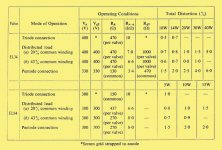one of my el34 got burnt after 6 month of service. I was putting it on an amp that was belong to 6550 Only by minor mod on bias voltage. I always notice the sound of over dissipated plate every time i turned off the amp after listening session. I read on claus brinth 30w pp article that 5k A-A was to tough for el34 triode mode. What would be a better option for me to run el34
1. Lowering the b+ voltage , or
2. Replace iron with higher plate to plate resistances
If opt 1 chosen , please recommend me safe b+ voltage into 5k a-a,
If opt 2 chosen , please share nominal a-a which sounds the best with el34 triode strapped based on your experience.
Thx and regards,
Andry
1. Lowering the b+ voltage , or
2. Replace iron with higher plate to plate resistances
If opt 1 chosen , please recommend me safe b+ voltage into 5k a-a,
If opt 2 chosen , please share nominal a-a which sounds the best with el34 triode strapped based on your experience.
Thx and regards,
Andry
one of my el34 got burnt after 6 month of service.
How much was the idle current/tube ?
Hi boywonder,
It's nice to hear from u again.
if your amplifier do stable with this operating condition,
Then mine surely had something wrong.
I was very confused of crackling sound every time i turn off the amp.
Is it normal? do grid leak resistor 100k for 6550 should be replace with usual 220k for el34?
It's nice to hear from u again.
if your amplifier do stable with this operating condition,
Then mine surely had something wrong.
I was very confused of crackling sound every time i turn off the amp.
Is it normal? do grid leak resistor 100k for 6550 should be replace with usual 220k for el34?
The crackling sound comes from different expansion coefficients of metal, mica and glass. When the tube is powered on or off there are some slight sudden movements which produce this sound. Tubes with self supporting system like that 211 or 845 without the mica on top wont produce that sound becausse they're clamped to the bulb only at the bottom and can expand in the top direction.
Nothing to worry about.
When you turn your car engine you hear a similar sound.
Aluminum heads on a cast iron engine block work well. So do iron anodes in glass tube.
Nothing to worry about.
When you turn your car engine you hear a similar sound.
Aluminum heads on a cast iron engine block work well. So do iron anodes in glass tube.
Is it normal? do grid leak resistor 100k for 6550 should be replace with usual 220k for el34?
Are you running cathode bias or fixed bias? Sounds like either of those grid leak numbers are reasonable; my amp has 150K grid leaks, and it's fixed bias (Poindexter's 6GK5/EL34 MM).
Can you provide more details on the amp circuit...
What Class of operation???
Can you describe the output stage....Cathode biased?? Fixed Bias??
Could you provide schematic ?
The idle plate dissipation is fine...The plate Load swing if it is too small will make the average plate dissipation too high and thus can eat up tubes faster than normal..
I wouldn't always trust the data sheet...need to do the analyis yourself..
Class AB1 can get away with much higher voltages....
cerrem
What Class of operation???
Can you describe the output stage....Cathode biased?? Fixed Bias??
Could you provide schematic ?
The idle plate dissipation is fine...The plate Load swing if it is too small will make the average plate dissipation too high and thus can eat up tubes faster than normal..
I wouldn't always trust the data sheet...need to do the analyis yourself..
Class AB1 can get away with much higher voltages....
cerrem
Here's another chart from Mullard (Mullard Circuits for Audio Amplifiers, chapter 3). They recommend 10k ohms a-a as total distorton is almost minimal (>1%) with a reasonable output of 14w for two triode-strapped EL34's in push-pull. Total distortion rises pretty quickly with load impedance <7K ohms!
An externally hosted image should be here but it was not working when we last tested it.
Maximum output power and the corresponding distortion vary appreciably with the value of load impedance. The curves of the above diagram illustrate the performance of two Mullard high-slope output pentodes, type EL34, connected as triodes in a push-pull output stage, operating slightly below their anode-dissipation rating of 25 W. For anode-to-anode load impedances below 7 kΩ, either a shared, bypassed cathode resistor or separate bypassed cathode resistors can be used. Above 7 kΩ however, improved operation is obtained if a shared resistor with no bypass capacitor is used. Operating conditions approach class A as the anode-to-anode impedance is raised, and the optimum performance for high-quality output stages is obtained with a load impedance of about 10 kΩ An output of l4 W is then delivered by the valves with total harmonic distortion well below 1%.
- Status
- This old topic is closed. If you want to reopen this topic, contact a moderator using the "Report Post" button.
- Home
- Amplifiers
- Tubes / Valves
- 5k plate to plate, el34 triode strapped, 400v b+
